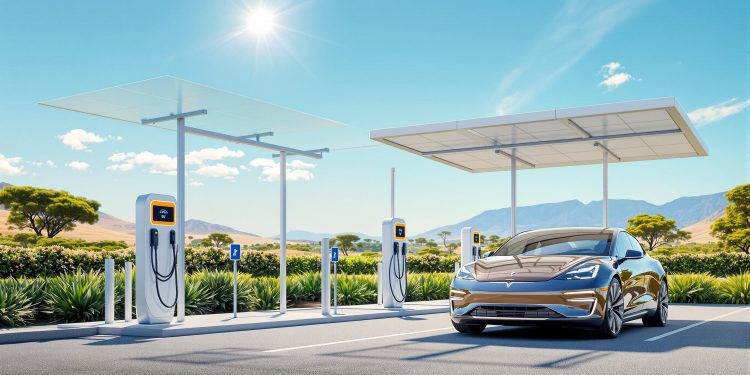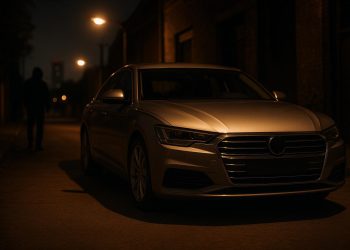In November 2024, South Africa launched its first off-grid, solar-powered EV charging station in Wolmaransstad. Here’s what you need to know:
- CO2 Savings: Each station reduces 54 tons of CO2 monthly (equivalent to planting 1,200 trees annually).
- Fast Charging: 18 minutes for a 300km range using 480kW DC chargers.
- Energy Setup: 480 bifacial solar panels (280kW), 546kWh battery storage, and a backup generator.
- Network Expansion: 120 EV and 120 truck-specific stations planned by Q1 2026.
- Rural Development: 5% revenue shared with landowners; local businesses and skills prioritized.
These stations are strategically placed along major highways, offering reliable, off-grid energy and contributing to South Africa’s Renewable Energy Masterplan. Keep reading for more details on how this project is shaping the future of clean transportation.
South Africa’s First Off-Grid EV Charging Station
Technical Details
The station is designed to align with its climate-focused objectives by integrating three key systems.
System Components
At the heart of the station’s infrastructure are:
- 280kW bifacial solar array (480 panels): These panels boost energy production by utilizing both direct sunlight and light reflected from the ground.
- 546kWh temperature-controlled battery storage: With an operating range of -10°C to 50°C, the liquid-cooled battery is well-suited for the extreme temperatures of the Northern Cape [6].
- 250kVA HVO backup generator: This ensures reliable energy availability when needed.
This setup reduces reliance on the grid and aligns with the project’s goals of supporting rural development.
Charging Options
The station offers advanced DC fast-charging infrastructure with four liquid-cooled units capable of delivering 480kW. These chargers are tailored for the quick charging needed during long-distance travel [3].
For plug-in hybrid vehicles, there are two 22kW AC chargers available [1]. The charging process is designed to be user-friendly and includes features like:
- Real-time charging updates via mobile apps.
- RFID card access for users without smartphones.
- Automatic load balancing to optimize charger performance.
- Flexible payment methods, including prepaid bundles [2][6].
The system’s smart software ensures efficient power distribution, prioritizing renewable energy sources across all charging points.
Station Locations
South Africa’s solar EV charging network has been strategically placed along major highways to provide dependable access for travelers.
First Station: N12 Wolmaransstad
The first solar EV charging station is situated at the N12’s Leeudoringstad turnoff, between Klerksdorp and Wolmaransstad in North West Province [1]. This location was chosen for its excellent solar exposure, utilizing 480 bifacial panels, and serves drivers traveling between Johannesburg and Cape Town [2]. It showcases how off-grid charging can work effectively in rural areas [3].
Future Stations
The network’s expansion is guided by specific criteria:
- Highway coverage: Stations will be placed along the N1, N2, N3, and N4 highways.
- Distance: No more than 150km apart, ensuring EV drivers can easily find a charging point within their vehicle’s range.
- Location specifics: Sites will cover 1-2 hectares and be located within 5km of major roads.
A large portion of the initial rollout will focus on the Free State province, with stations planned in 13 municipalities [4]. To support rural economies, station sites will often be co-located with local businesses, making them convenient for travelers and beneficial for the surrounding communities [2].
The first phase aims to complete stations along the Gauteng-Cape Town-Durban routes by mid-2025 [4].
sbb-itb-09752ea
Key Advantages
These solar EV charging stations offer a range of benefits across three main areas:
User Benefits
Drivers enjoy around-the-clock access to charging, enhanced by security surveillance, 25-minute DC fast charging, and added conveniences like farm stalls [2][8]. Key features include:
- Secure mobile payments and real-time updates on station availability [1][2].
- Covered charging bays, shielding vehicles from harsh weather [3].
- Integrated amenities such as food, drinks, and rest options at farm stalls [2][7].
Host Benefits
Property owners hosting these stations experience economic gains while supporting green initiatives:
- Infrastructure that appeals to eco-conscious travelers [2].
- Boosted foot traffic for on-site businesses [7].
- Opportunities for local skills development through maintenance collaborations [4].
A revenue-sharing model ensures these stations contribute directly to rural development goals.
Carbon Reduction
By avoiding Eskom‘s coal-heavy grid, these stations cut emissions from both EVs and the charging process. Here’s a comparison of emissions:
| Vehicle Type | CO2 Emissions per km | Annual CO2 Output (20,000 km) |
|---|---|---|
| Station-Charged EV | 0g | 0 tons |
| Grid-Charged EV | ~0.9kg/kWh | ~3 tons |
| Petrol Vehicle | 120-150g | 2.4-3 tons |
Charging an EV at these stations can save about 3 tons of CO2 annually compared to grid charging [3][4]. On a broader scale, the stations collectively reduce CO2 emissions by 54 tons every month.
Station Reliability
Reliable performance is essential for maximizing the stations’ energy and cost-saving potential.
Weather Solutions
These stations are designed to handle tough weather conditions, thanks to advanced technical features:
| Weather Challenge | Technical Solution | Performance Impact |
|---|---|---|
| Extreme Heat | Liquid-cooled cables and charging systems | Operates smoothly in temperatures up to 45°C [8] |
| Rain/Moisture | Waterproof enclosures | Full protection against water damage [3] |
| Extended Cloudiness | Battery system | Provides over 36 hours of backup power [3] |
| Night Operation | Automated power management system | Effortless switch to stored energy [2] |
Off-Grid Operation
Running independently from Eskom’s grid brings major reliability benefits. A three-tier system – solar power, battery storage, and emergency backup – ensures operations continue without interruptions. This setup is particularly useful for supporting rural areas by removing the need for grid connections.
Solar and battery systems handle most daily operations, while the backup system is used sparingly, averaging just two activations per month – a 90% reduction compared to fuel-reliant sites [4][8].
Performance is monitored remotely through the CHARGE app, and the modular design allows for fast, 4-hour component replacements [3].
"During testing, the HVO backup only activated twice monthly on average versus daily generator use at comparable fuel-based sites" [8]
This approach not only strengthens the project’s focus on clean energy but also helps tackle South Africa’s load-shedding issues effectively.
Looking Ahead
Key Takeaways
CHARGE’s network expansion is set to roll out in four phases, focusing on both passenger and freight vehicles. Here’s a breakdown of the next steps:
| Phase | Timeline | Details |
|---|---|---|
| Phase 2 | Sept 2025 | Development of the Free State network, including partnerships with rural businesses. |
| Phase 3 | Early 2026 | Nationwide rollout of 75 passenger stations and 45 truck stations. |
| Phase 4 | Post-2026 | Addition of 120 more truck stations. |
This dual approach supports both passenger and freight transportation, with truck stations playing a key role in cutting emissions. These efforts build on the emission reduction strategies discussed earlier in the Carbon Reduction section [4].
"Three years of R&D including real-world testing with Volvo EX30 vehicles has proven the technical viability of this solar charging model", says Joubert Roux, Zero Carbon Charge Chairman [3].
More Information
For ongoing updates about South Africa’s EV charging infrastructure and green transport efforts, visit ImotoNews South Africa at https://imotonews.co.za. You can also check real-time station availability via the CHARGE mobile app [2][5].
This expansion supports South Africa’s Renewable Energy Masterplan, which launches in 2025. With truck-specific stations designed to reduce freight emissions, the network will provide fully grid-independent charging solutions across the country [3].
Related Blog Posts
- Fuel-Saving Tips for Long South African Road Trips
- SA EV Sales Growth 2025: Key Numbers
- EV Buyers in South Africa: Emissions and Behavior
- Export Tax Incentives: Boosting SA Auto Exports





